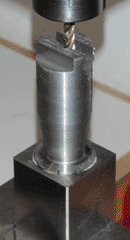
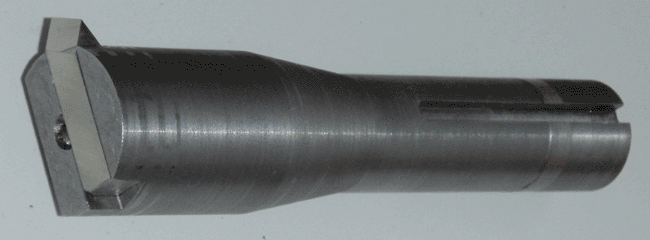
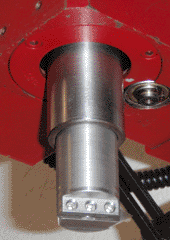
The cutter used in my earlier gear experiments, while adequate for its original purpose, is generally only suitable for small gears with a large number of teeth. To broaden my gear-making capabilities, I decided to make a larger cutter which fits directly into the spindle of my milling machine, having increased rigidity as well as a larger maximum tooth width.
The new cutter was made from a 5-1/2" length of 1-3/8" steel bar, cut from the same stock that I used for my die holder. It was originally an axle of some sort, which I found buried in the yard about a decade ago. Its stiffness and rust resistance lead me to believe it is some sort of alloy steel, and I have found it well suited to toolmaking. The lower end of the cutter has three 1/4"-20 set-screws, which hold a 5/16" lathe bit between two jaws of the same width. The upper end has a standard R-8 profile and seats firmly into the mill spindle, with no indication of any error in the taper. When installed in the mill, the center line of the cutting bit is approximately 3-3/8" below the underside of the mill head, providing ample clearance for my spin indexer. Various stages of the machining process can be seen below; all major turning operations were done with a zero-rake universal tool, and all finishing passes were made with my shear tool.
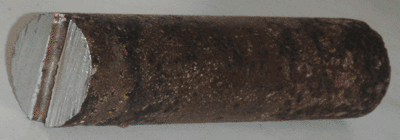

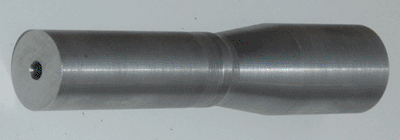

Test cuts reveal that the rigidity of this tool is significantly improved over the previous iteration; the cutter deflects less during operation, resulting in a cleaner cut with less of a hammering effect. Pushing the tool to its limit, I found that it could cut teeth nearly 3/16" deep in mild steel (by making successively shallower passes) before the hammering became excessive for both the mill and the cutting bit; however, the limiting factor here appears to be the length of the active cutting surface, so larger teeth could likely be cut if the sides of the groove were relieved before plunging deeper. Furthermore, steel is notoriously abusive to gear cutters; for softer materials such as brass or aluminum, a larger tooth depth could be achieved directly.
Overall, this gear cutter is adequately sized for the scale of work I intend to produce, and larger gears would likely require an entirely different method of construction (even with larger machine tools) due to the increasing cutting forces and decreasing rigidity of this setup. Despite this limitation, this is still by far the simplest method of making gears in the home workshop, and I look forward to testing the gears produced in this way.